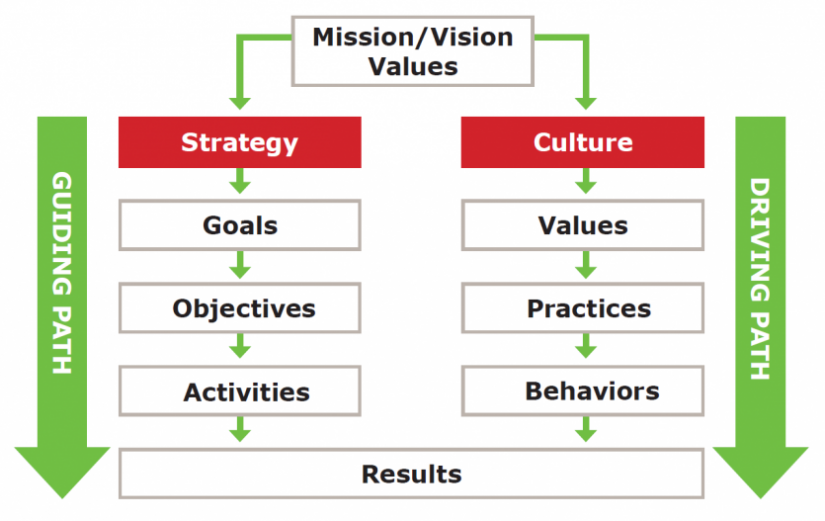It’s not enough anymore to just create the strategy
The competitive environment is shifting again. It’s not enough anymore to just create the strategy. It’s not enough to build out the tactics to implement the corresponding initiatives. It’s not even enough to institutionalize good change management practices. All is for not, if you don’t align the core foundation of your company, the corporate culture.
A strategy can be written in short order and communicated to the organisation by using multiple mediums in a matter of weeks – and can be adjusted and changed if needed. Corporate culture, on the other hand, is a big deal. Sadly it’s something many organisations don’t seem to understand – “Culture eats strategy for breakfast”.
Culture and strategy need to eat lunch together
Culture and strategy need to eat lunch together – because a good organizational strategic plan includes culture.
Companies are not linear, inert systems. They are ever-changing, organic communities that are dependent on the engagement, talent, and energy of their people to operate successfully. Ignore the mental well-being of your people and corporate culture at your own peril.
Culture is either driving the strategy or undermining it
Step inside any company, no matter the size, stage of development, or level of success, and the culture is either driving the strategy or undermining it. To exist in the first place, a company must have a clear purpose, a deliberate intent, and a set of ideas that it uses to pursue a clear goal – but it’s the people who have to execute it.
People matter. More than machinery, products, or real estate. People invent and build. People support and serve customers. Your people either create or undermine value, cultivate or kill relationships, drive or reduce success.
A well-conceived strategy living in the hands of unhappy, misdirected, misinformed people is a sure way to a slow and painful death. There is no comparison to being in the hearts and hands of energized, informed, and motivated people.
Eat your competition for lunch
So, if your company’s strategy includes a focus on establishing and maintaining a positive culture, the organization won’t be munching on itself – and you can all eat your competition for lunch.
Short URL & title:
Corporate culture is driving the strategy or undermining it — http://www.torbenrick.eu/t/r/cwj
Share it:
If you enjoyed this article, please take 5 seconds to share it on your social network. Thanks!








Great article Torben! As a consultant I, unfortunately, come across managers who have been through the corporate culture building exercise many times with little success. Been through it a few myself. In the US oil industry I watched high paid consulting groups try to micromanage a cultural shift. They detailed how employees were to organize, communicate and interact. The methods you describe here, enabling the employees to build the culture around the company vision and mission, is right on target.
Mmmm … the Old Chestnuts …. and (with respect) still going around and still missing the point. Which is! … one word, “Leadership” (not given a single mention).
In the week of Mandala’s call to eternity, his life offers clues as to how we mere mortals might best influence the future.
Only a combination of a leaders committment and inspiration with personal qualities engendering respect and love (Yes Love!) will foot it. [They have to like you … to follow you.]
This mix will have groups of humans ceding their personal whims to the greater good.
If all of this seems too hard to believe, simply try focussing on shared direction(strategy) coupled with the implementation of a default, flat remuneration scheme rewarding excellence at all levels… and measure the “culture/performance” progress.
Great article,
this is exactly the reason why I changed jobs 7 years ago. All described elements are in the company I work for today, which makes me get out of bed each morning with a smile !
Kind regards,
Alain Loots
Commercial Manager
Den Hartogh Liquid Logistics BV
I like this – strategy and culture work together, and cannot really be separated. Good analogy!
If vision is a dream, then strategy is the path you tread in that dream. Dreams remain dreams unless acted upon. However, action or lack of it is determined by habit (i.e. culture). The way to realise the vision is to live the dream and enlist your org to live the same dream and tread the path with you. Results can be achieved and visions realised if you have leaders who lead from the front and create a culture of winning and sharing success.